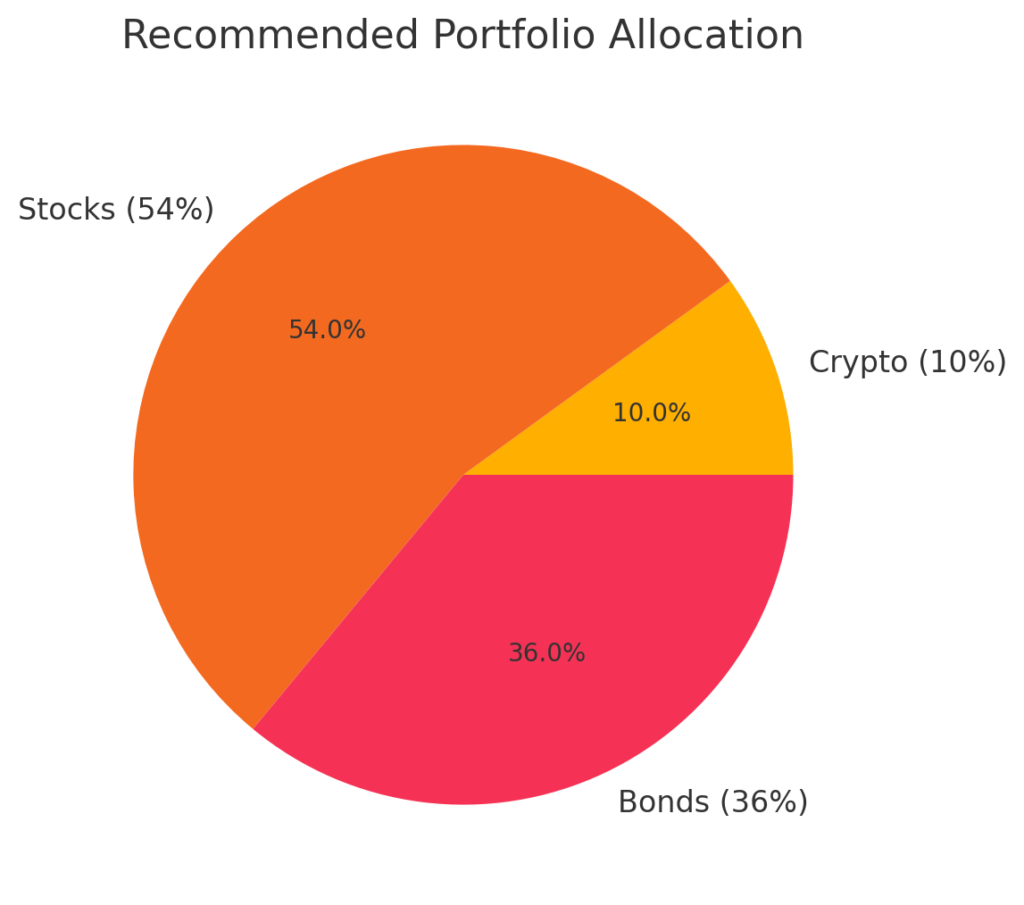
Main Points:
- Institutional Adoption Is Surging
- Edelman’s Allocation Shift: From 1% to 10–40%
- Diversification & Low Correlation Benefits
- Aging Demographics Demand New Growth Engines
- Fixed Supply Assets Offer Upside Potential
- Record ETF Inflows & AUM Growth
- Family Offices & Wealth Managers Embrace Crypto
- Regulatory Clarity Accelerates Access
- Practical Blockchain Use Cases Continue Expanding
- Start with 10%, Adjust to Your Risk Tolerance
1. Institutional Adoption Is Surging
Over the past eighteen months, we’ve witnessed a dramatic shift as traditional financial giants embrace cryptocurrency. The U.S. Securities and Exchange Commission’s approval of spot Bitcoin ETFs in January 2024 marked a milestone, opening the door for mainstream asset managers to allocate capital to digital assets without the complexities of self-custody. In May 2025 alone, U.S. spot Bitcoin ETFs pulled in over $1.7 billion, while Ethereum ETFs attracted $206 million in new capital. BlackRock’s IBIT ETF leads the pack with a cumulative $46.9 billion in inflows since inception and over $125 billion in assets under management. Such large-scale participation is hardly accidental—it reflects growing confidence that crypto has evolved beyond its niche origins.
2. Edelman’s Allocation Shift: From 1% to 10–40%
Rick Edelman, founder of the Digital Asset Expert Council, has long been a mainstream voice on financial planning. In 2021, he suggested a modest 1% allocation to crypto for most investors. As of June 30, 2025, he boldly recommends increasing that to at least 10%—and for aggressive investors, up to 40%—of total portfolio assets. He argues that the maturation of technology, widespread regulatory frameworks, and institutional participation have transformed digital assets into “the best investment opportunity in a decade.” Edelman emphasizes adjusting this range to personal risk tolerance: conservative investors should allocate a minimum 10%, while those with higher risk appetite may consider larger positions.
3. Diversification & Low Correlation Benefits
Crypto’s appeal extends beyond price appreciation. Historically, Bitcoin and major altcoins have exhibited low correlation with equities, bonds, and commodities such as gold. This means adding a 10% crypto sleeve can enhance portfolio diversification and potentially raise risk-adjusted returns. According to research by CoinShares, bitcoin and ether funds saw net inflows of $5.5 billion and $890 million respectively in May 2025—while global equity funds actually experienced $5.9 billion in outflows. This reallocation underscores crypto’s growing role as a non-correlated hedge, especially in an environment of elevated bond yields and equity market volatility.
4. Aging Demographics Demand New Growth Engines
Longer life expectancies pose challenges for traditional 60/40 portfolios over multi-decade horizons. Projected retirement periods stretching beyond 30 years necessitate assets capable of delivering outsized growth. Crypto’s long-term total return since inception far exceeds that of stocks or gold, albeit with higher volatility. By introducing a 10% allocation, investors bolster their chance of capturing significant upside, helping to fund longer retirements and intergenerational wealth transfers.
5. Fixed Supply Assets Offer Upside Potential
Bitcoin’s capped supply of 21 million coins sets it apart from inflationary fiat and many digital tokens. As adoption widens—currently estimated at roughly 5% of global investable assets—demand is poised to outpace available supply, driving price appreciation. Models projecting $120 billion in institutional inflows by year-end 2025 and up to $300 billion in 2026 further reinforce a bullish outlook . While volatility remains, the structural dynamics of fixed supply favor higher long-term equilibrium prices.
6. Record ETF Inflows & AUM Growth
Institutional product inflows have set new records throughout H1 2025. As of mid-June, U.S. spot Bitcoin ETFs amassed nearly $11.5 billion in 2025 alone, driven primarily by BlackRock’s IBIT (accounting for 96% of recent inflows) and growing traction for altcoin ETPs. This tide of capital has propelled Bitcoin’s price rally—up 74% year-to-date, stabilizing near $105,000 in late June—illustrating that institutional demand remains a cornerstone of current market strength.
7. Family Offices & Wealth Managers Embrace Crypto
According to a BNY Mellon report, 39% of single-family offices are already holding or exploring crypto exposure, up from 25% just 12 months prior. Family offices typically demand robust due diligence and regulatory clarity before allocating client capital. Their willingness to adopt—even at modest 2–5% levels—signals that digital assets have crossed a threshold from speculative fringe into strategic asset class.
8. Regulatory Clarity Accelerates Access
Major regulatory milestones have reduced uncertainty. In the U.S., spot Bitcoin and Ether ETFs operate under SEC surveillance-sharing agreements to minimize manipulation risks, while Europe’s MiCA framework has enabled BlackRock to launch an iShares Bitcoin ETP in Zurich, Xetra, and Euronext markets with attractive fee waivers through year-end 2025. Meanwhile, approval of in-kind redemption for Ethereum ETFs is anticipated by June 1, 2025, facilitating smoother creation and redemption processes for large-scale investors. This evolving infrastructure simplifies portfolio integration and custody.
9. Practical Blockchain Use Cases Continue Expanding
Beyond pure investment, blockchain applications in enterprise and DeFi are rapidly maturing. DeFi platforms now handle over $50 billion in TVL, with institutional wallets actively engaging in liquidity provision and staking services. Global banks pilot tokenized asset trading, cross-border settlement, and digital identity solutions on blockchain rails. These real-world use cases validate the technology’s utility, creating an expanding ecosystem that underscores the fundamental value of digital assets.
10. Start with 10%, Adjust to Your Risk Tolerance
Based on the above factors, a 10% allocation serves as a balanced entry point for most investors. It captures the diversification, growth potential, and inflation hedge benefits of digital assets without overwhelming traditional holdings. More aggressive investors may scale up to 20% or 40%, while conservative profiles can remain closer to the 10% floor—always calibrated to individual goals, timelines, and risk appetite.

Conclusion
In light of institutional adoption surging, evolving regulatory clarity, and compelling economic arguments—from low correlation benefits to fixed supply dynamics—allocating at least 10% of your portfolio to crypto assets represents a rare, once-in-a-decade opportunity. As traditional 60/40 strategies face headwinds in a world of longer retirements and inflationary pressures, digital assets offer a complementary growth engine with the potential for outsized long-term returns. Start with a measured 10% allocation, stay informed on emerging blockchain use cases, and adjust your position as the crypto ecosystem continues its maturation.

